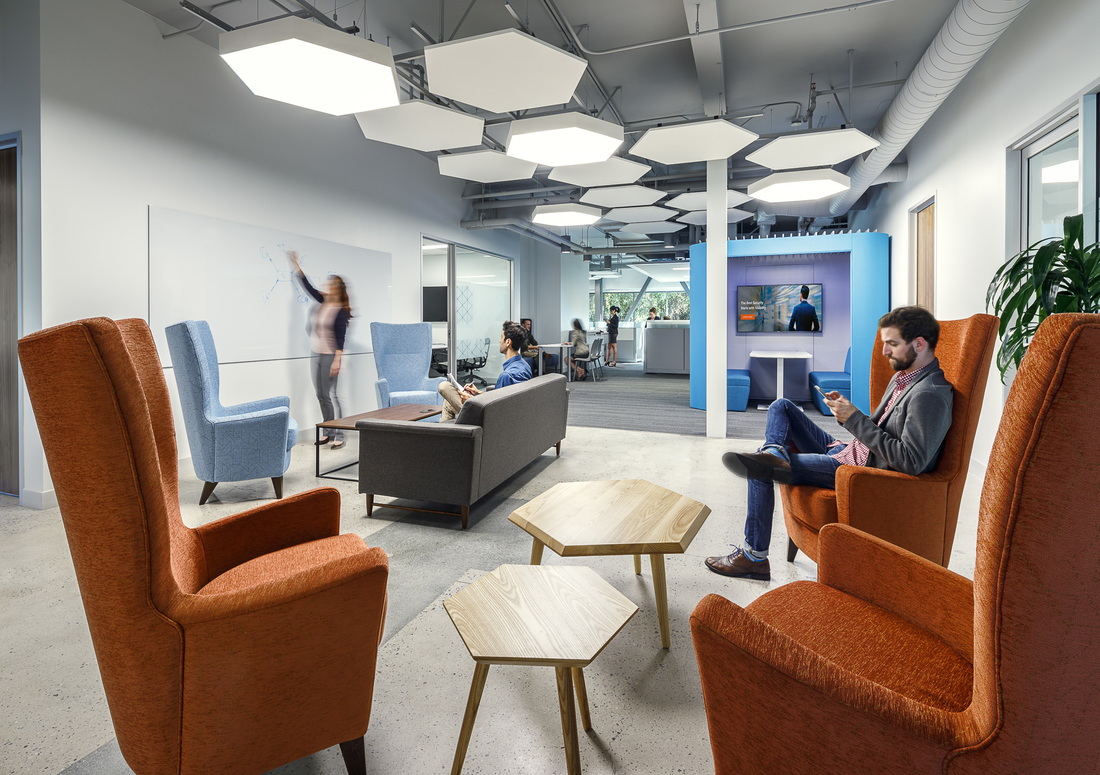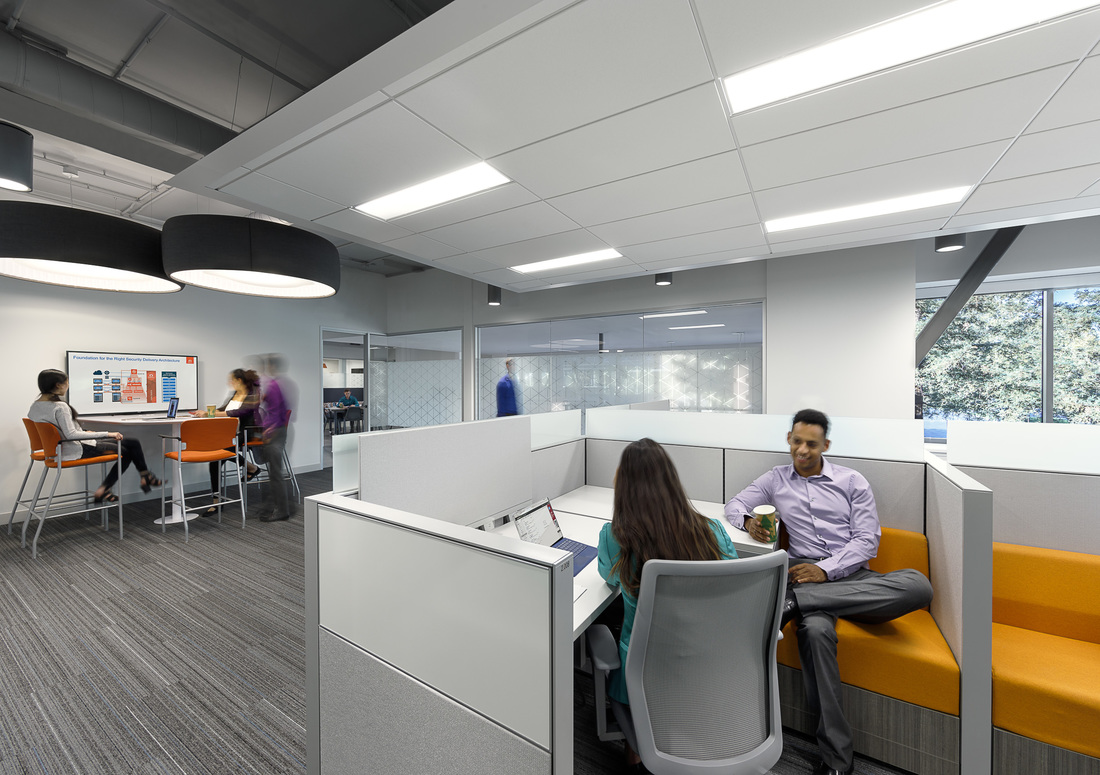Robin Weckesser of a3 Workplace Strategies shares why execs are questioning open environments in favor of adopting hybrid solutions.

Workers in the Bay Area and beyond are returning to the office at a faster clip, with a 36% occupancy level reported in October 2021. But what kind of office will they find? As the effects of the pandemic linger, the “new normal” will likely lead to the “next normal,” and it’s clear that the “old normal” will never return.
The views of employees will affect how employers move forward: Most workers today want the option to work from home at least half of the time, and they want assurances that safety protocols will be in place when they go back. Does this mean the open office, such a prominent trend pre-COVID, is dead? Not necessarily. But the challenges of these still-uncertain times have slowed the growth of open environments and have spurred hybrid arrangements.
In pre-pandemic days, 70% of office-based employees worked in open-plan environments. Early studies about open offices touted that they cut costs with a reduced space requirement, promoted collaboration, and possibly increased innovation. Yet few studies addressed the obstacles of open offices, including cramped spaces and annoying distractions.
Opening the Door to Alternative Solutions
The pandemic has probably changed the workplace and employee attitudes forever. Today, surveys show 70% of employees will seek new jobs if not given the opportunity to work from home at least part-time; this is tied to fears about virus transmission and a corresponding demand for healthy workplace conditions that open offices may not ensure.
A recent scientific study by QB News explored a major open-office drawback: the effect of noise. The study, conducted in a simulated work setting for eight days, involved sensors and AI facial recognition to measure heart rate and sweat, reliable indicators of stress.
Dramatic results include:
- A clear relationship between noise and physiological stress.
- Noise heightens negative mood by more than 25% and sweat response by 34%; these numbers would be higher if the study were extended long-term.
- Chronic negative moods will likely diminish job satisfaction and commitment.
- Prolonged stress will likely be detrimental to physical and mental health as well as productivity.

Dealing with New Realities
As we accept that the workplace of the future is here and the world continues to be in flux, organizations must re-evaluate their strategies and navigate the turbulence of today and tomorrow. With the survival of their organizations at stake, corporate real estate executives must be courageous and venture out of their comfort zones. Topping their agendas is how their workplaces will adapt.
Immediate considerations:
Optimizing workplace safety and health.
This includes practicing vetted COVID protocols as well as deciding whether to mandate vaccines, testing, physical distancing, and masking (ideally following guidelines issued by the U.S. Centers for Disease Control and Prevention). In this light, it is prudent to review the return-to-work plans of other organizations. These vary from the strict mandates of Google and Facebook—that all domestic employees be vaccinated before returning to the office—to Microsoft’s less stringent approach that allows for variations and exceptions. Also, as a possible portent for the professional services industry, accounting giant PricewaterhouseCoopers recently announced it is allowing 40,000 of its 55,000 employees to work from home in the United States. But what about your plans? In the final analysis, the unique requirements of your organization will dictate what numbers work best.
Providing accommodations for a virtual workforce.
The advantages of working from home were evident before the pandemic—and they have crystallized even more so since. Employers appreciate the reduced cost of occupancy as well as the time—along with the carbon footprint—that is saved with no commute; they can also cite studies on greater productivity for virtual workers and longer dedicated hours with fewer interruptions. At-home workers appreciate the flexibility, transportation cost savings, and reduced stress. So, even while employers may be concerned about control and accountability of their workforce, they recognize the inevitable continuation of remote work. And they should enhance connectivity and communication, including refinements for virtual meetings.

Providing a welcoming workplace.
Of course, working at home can increase feelings of isolation, and all workers need personal interaction. Meanwhile, organizations need to plan for periodic, all-hands meetings at the office. But when staff and guests ultimately return, it should be to an inviting environment that makes them feel at home. This includes hybrid arrangements with private areas, a thoughtful seating plan, and amenities that include natural lighting, lounges, fitness provisions, no-contact food service, and other wellness accommodations. A welcoming workplace is also one that mitigates distractions and ambient noise. Acoustics can be controlled through advanced sound-masking technologies (e.g., products for flooring, tiles, walls, and ceilings) as well as old-fashioned partitions.
Revisiting the importance of culture.
Of course, it is crucial to address corporate culture, which is especially challenging with today’s fragmented nature of work. This involves a shared vision and values, as well as a sense of community—i.e., interaction and collaboration. Also not to be overlooked is the needed integration of culture with branding/marketing, which includes messaging and signage to motivate staff. In addition, engaging staff is a key part of this equation, and that begs the need for education and training. Indeed, an engaged staff increases loyalty—and this is most relevant since a recent Gallup Poll shows just 35% of employees are committed to their jobs. The fact is, we live in a time of mistrust and polarization, as well as increased COVID-related employment law suits (California tops the nation in such litigation). A proper response from corporations? Heightened sensitivity to the need for inclusion and diversity with a multi-ethnic, racial, and generational workforce. In other words, putting people first.
As a final perspective, the return to the workplace definitely isn’t an open/shut proposition. One size doesn’t fit all.
To find the best fit, it’s wise to do your due diligence and review best practices and well as recent studies…though studies don’t always agree.
One thing we have learned is that we should listen to employees, who are not a monolithic group. Many want to work from home. Many don’t. To be sure, the vast majority are uneasy due to today’s volatility, and they prefer choice, flexibility, and transparency. That often translates into a hybrid office arrangement, which research shows also helps in the recruitment of top talent in a tight labor market.
We have also learned that organizations need to invest in the most experienced consultants to provide the most effective solutions. When seeking qualified project managers, make sure they offer change management as part of their skillset.
In short, in the throes of these chaotic times, organizations have a unique opportunity to re-purpose their space and re-set their priorities. It’s a turbulent time, but an exciting time. A time for an open mind, whatever the office environment.

